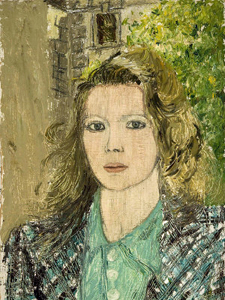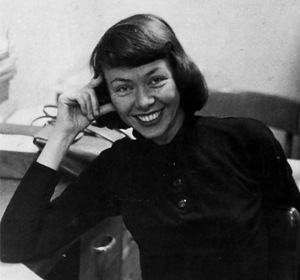
Marjorie Kramer (born 1943 in Englewood, NJ, raised in Greenwich, CT) is a figurative painter of al fresco landscapes and feminist self-portraits. [1]

Marjorie Kramer (born 1943 in Englewood, NJ, raised in Greenwich, CT) is a figurative painter of al fresco landscapes and feminist self-portraits. [1]
Kramer has a BFA from Cooper Union and was a founding student in 1964 at the New York Studio School of Drawing, Painting and Sculpture, and studied with Mercedes Matter, Charles Cajori and Louis Finkelstein. She donated a portion of her small inheritance to pay the School’s first month’s rent of $500. [2]
Kramer was a founding editor with Irene Peslikis and others of the Woman and Art Quarterly (1969–71), the first women artists' publication. From 1968 to 1973, Kramer organized shows of work by women artists, including SoHo Women's Artists in a Canal Street loft with Women Artists in Revolution (WAR) and Feminist Art at Columbia University with Patricia Mainardi. [1] With these friends, she participated in New York Radical Women in 1968 and in January 1969 was involved in the founding of the radical feminist collective Redstockings. In their first press, The Village Voice reported that the women felt they were taking charge of their own bodies finally. [3] Kramer’s response was First Self Portrait (1970). The expression on her face led Larry Campbell, in ARTnews to write of a plucky artist with attitude. [4]
In 1971, Kramer combined her art and politics in Open Show of Feminist Art at a space run by Art Workers Coalition called MUSEUM: A Project of Living Artists at 729 Broadway, which was supported by a New York State grant; she put ads in alternative weeklies and posted flyers downtown saying that ALL woman artists were welcome with a $1.50 donation to help cover the costs. [5] It was only woman because they don't get chances to show their work, Kramer told the Daily News, which called the group the "Anti-Oppressionists." [6] Among the roughly 125 participating artists were Alice Neel, Faith Ringgold, and Gretna Campbell; another participant, Juanita McNeely hauled a large painting about menstruation to the show, hung it herself, and thought, "I felt immediate love and at home. We women artists were no longer alone." [7] Lawrence Alloway wrote that this show affirmed the artists' control over their own work, a necessity in the anti-authoritarian women’s movement. [8]
Alice Neel, at 71, couldn’t transport her paintings to the show, so Kramer and Noah Baen picked them up. Neel said they could take anything and they took her portrait of the outrageous Joe Gould, painted in 1933. [9] Neel remarked that she had received little attention in the art world, and had never been in the Whitney Annual, which led Kramer to write a petition to the Whitney Museum about their exclusion of this major painter. Working on it with Baen and Cindy Nemser, they gathered 100 signatures of artists, [10] which was instrumental in the staging of Neel’s Whitney retrospective in March 1974. [11]
There were other one-woman shows throughout the eastern U.S. Ken Johnson, in a New York Times review, found Kramer to be a realist painter with a delicate painterly touch in her solo show at 55 Mercer. [12] Group shows included the National Academy Museum and School, Grey Art Gallery at New York University, Dishman Art Museum, [13] and others.
In 2003, Kramer was awarded the Veteran Feminists of America Medal in the Salute to Feminists in the Arts from the National Arts Club in New York. [14] In 2007, she won a New York Studio School Painting Residency on Governors Island. [15]
Kramer was a founding coordinator of the Artists' Choice Museum in New York in 1976. [13]
Called a neomodernist for her observational rigor, her work was considered to have upset the traditional male subjects-system of self-portraiture. [16]
Much of her landscape painting is from her current home in Northern Vermont, which has led her to working with the Vermont Progressive Party, which focuses on political equality and ecological policy with its members in the Legislature and in the Governor’s office. She was campaign manager for two of their nominees, [17] as well as working with the local Community Supported Agriculture group for better stewardship of the land. [18]

Alice Neel was an American visual artist, who was known for her portraits depicting friends, family, lovers, poets, artists, and strangers. Her paintings have an expressionistic use of line and color, psychological acumen, and emotional intensity. Her work depicts women through a female gaze, illustrating them as being consciously aware of the objectification by men and the demoralizing effects of the male gaze. Her work contradicts and challenges the traditional and objectified nude depictions of women by her male predecessors. She pursued a career as a figurative painter during a period when abstraction was favored, and she did not begin to gain critical praise for her work until the 1960s. Neel was called "one of the greatest portrait artists of the 20th century" by Barry Walker, curator of modern and contemporary art at the Museum of Fine Arts, Houston, which organized a retrospective of her work in 2010.

Linda Nochlin was an American art historian, Lila Acheson Wallace Professor Emerita of Modern Art at New York University Institute of Fine Arts, and writer. As a prominent feminist art historian, she became well known for her pioneering 1971 article "Why Have There Been No Great Women Artists?" published by ARTnews.

Florine Stettheimer was an American modernist painter, feminist, theatrical designer, poet, and salonnière.

Sylvia Sleigh was a Welsh-born naturalised American realist painter who lived and worked in New York City. She is known for her role in the feminist art movement and especially for reversing traditional gender roles in her paintings of nude men, often using conventional female poses from historical paintings by male artists like Diego Vélazquez, Titian, and Jean-Auguste-Dominique Ingres. Her most well-known subjects were art critics, feminist artists, and her husband, Lawrence Alloway.

Rosalyn Drexler is an American visual artist, novelist, Obie Award-winning playwright, and Emmy Award-winning screenwriter, and former professional wrestler. Although she has had a polymathic career, Drexler is perhaps best known for her pop art paintings and as the author of the novelization of the film Rocky, under the pseudonym Julia Sorel. Drexler currently lives and works in New York City, New York.
Kay Kurt is an American new realist painter known for her large-scale candy paintings.

Marjorie Virginia Strider was an American painter, sculptor and performance artist best known for her three-dimensional paintings and site-specific soft sculpture installations.

May Stevens was an American feminist artist, political activist, educator, and writer.
Harmony Hammond is an American artist, activist, curator, and writer. She was a prominent figure in the founding of the feminist art movement in 1970's New York.
John Lucas Perreault was a poet, art curator, art critic and artist.
Lila Katzen, born Lila Pell, was an American sculptor of fluid, large-scale metal abstractions.

Nicole Eisenman is French-born American artist known for her oil paintings and sculptures. She has been awarded the Guggenheim Fellowship (1996), the Carnegie Prize (2013), and has thrice been included in the Whitney Biennial. On September 29, 2015, she won a MacArthur Fellowship award for "restoring the representation of the human form a cultural significance that had waned during the ascendancy of abstraction in the 20th century."

Joan Semmel is an American feminist painter, professor, and writer. She is best known for her large scale realistic nude self portraits as seen from her perspective looking down.
Irene Peslikis was an American feminist artist, activist, and educator. She was one of the early founders and organizers in the women's art movement, especially on the east coast.
Cindy Heller Nemser was an American art historian and writer. Founder and editor of the Feminist Art Journal, she was an activist and prominent figure in the feminist art movement and was best known for her writing on the work of women artists such as Eva Hesse, Alice Neel, and Louise Nevelson.
June Druiett Blum was a multimedia American artist who produced paintings, sculptures, prints, light shows, happenings, jewelry, art books, pottery, conceptual documentations, and drawings. She was also a feminist curator and activist who worked to advance the women's movement and increase visibility for women artists.
Sharon Wybrants is an American painter, performance artist, and educator.
Clarity Haynes is a queer feminist American artist and writer. She currently lives and works in New York, NY. Haynes is best known for her unconventional painted portraits of torsos, focusing on queer, trans, cis female and nonbinary bodies. She is a former member of the tART Collective and the Corpus VI Collective.
Elke Solomon is an artist, curator, educator and community worker. She is known for her interdisciplinary practice that combines painting, drawing, object-making, performance and installation. She has exhibited widely in the United States and abroad.

Jane Kaufman was an American artist who was affiliated with the Pattern and Decoration movement. She was also a member of the art group Guerrilla Girls.